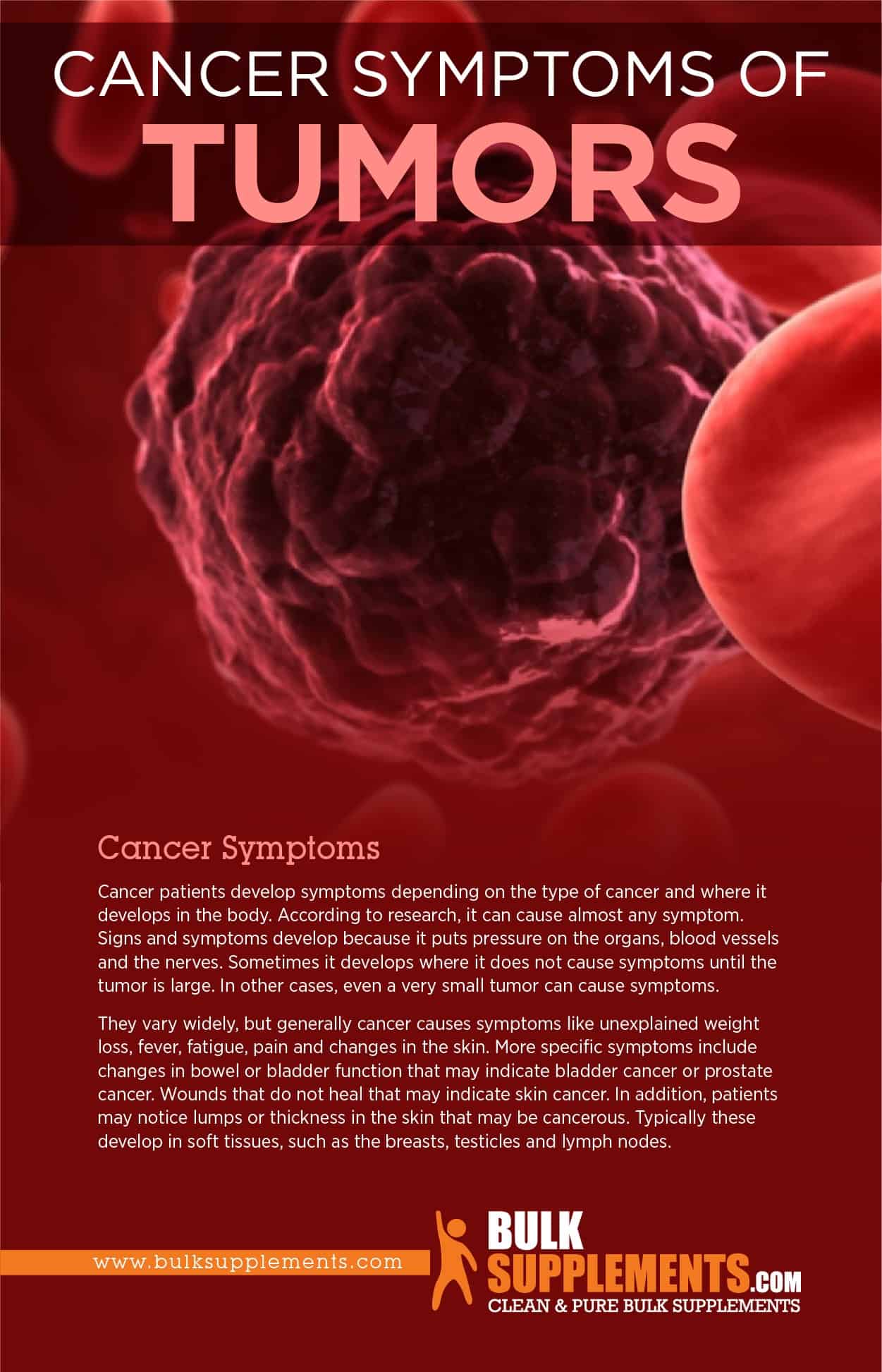Types of Tumors: Benign, Malignant & Premalignant

Types of Tumors
What is a Tumor?
A tumor is a growth in the body formed by groups of abnormal cells. Healthy cells normally grow and divide, reproducing new cells in a consistent an organized manner. However, in some cases, the cells grow and divide abnormally. If the body does not get rid of dead cells they can accumulate. They may replicate very rapidly in an unorganized way, which causes a tumor to develop. Although patients often use the words “tumor” and “cancer” interchangeably, not all tumors are cancerous. There are different types—benign, premalignant and malignant—and they often behave very differently. Tumors can develop at any age, but the risk is usually greater with age.
Tumors vs. Cysts
Sometimes patients may mistake a cyst for a growing tumor. A cyst is an abnormal growth on the body, but it is not the same as a tumor. A cyst is a sac filled with fluid, air or semisolid material. They commonly grow on the skin, breasts, ovaries, testes, kidneys or the spine. Typically they develop as a result of an infection, a defect during fetal development or from trauma to the skin.
Benign Tumors
Benign tumors are not cancerous. They do not spread or destroy nearby tissue and they may be easier to remove. In most cases, benign tumors do not return once they are removed. However, benign tumors can cause life-threatening damage if they develop in the brain and they may also develop into cancer.
Types of Benign Tumors
Benign tumors can grow on any part of the body. Usually researchers classify them based on where they grow:
- Adenomas – grow on thin layers of tissue on internal organs and glands
- Fibroids – develop on the tissues
- Nevi tumors – moles on the skin
- Osteochondromas – cartilage and bone overgrowth
Even though they are not cancerous, some benign tumors may cause health complications. For example, fibroids may cause pain and abdominal bleeding. A tumor may also restrict blood flow if it presses on a blood vessel and pain if it puts pressure on a nerve. In addition, a mole is typically harmless, but if it changes or spread it may be a sign of cancer.
Signs of a Benign Tumor
Benign tumors may not produce any signs or symptoms. The patient may notice swelling or persistent pain in the area or sometimes patients may be able to feel the growth if it is close to the skin. If a patient does have symptoms, they vary depending on the tumor’s location and the organs it affects. For example, uterine fibroids may cause symptoms like abnormal vaginal bleeding and pelvic pain and it may affect the patient’s ability to control the bladder. If a tumor develops in the brain, it may not cause specific symptoms, but it can cause general ones like headaches, nausea, vomiting, problems with vision and memory, seizures or facial paralysis.
Risk Factors
In most cases, physicians cannot directly identify the exact reason why a patient may develop a non-cancerous tumor. For example, researchers do not link brain tumors to any specific causes, but there are factors that can increase the risk, including radiation exposure, family history and a compromised immune system. These do not necessarily mean that a patient will develop a tumor and other patients may develop one without any common risk factors.
Malignant Tumors
Malignant tumors develop the same way as benign growths—from rapid and abnormal cell growth. But unlike benign growths, these are cancerous and they spread to other tissue and organs nearby. The cells can break off and travel through the bloodstream, the lymphatic system or the body cavities. These cells can grow very rapidly and form new cancerous growths in different tissues and organs.
Types of Cancer
Medical researchers group different types of cancer based on the type of cell that they start in. They may also classify them based on where they develop in the body, such as breast cancer or lung cancer. Physicians typically recognize five main types of cancer.
- Carcinoma – starts in the epithelium cells in the skin and tissue lining
- Sarcoma – begin in connective tissues in the cartilage, nerves and bone
- Leukemia – starts in blood forming tissue, such as the bone marrow
- Lymphoma and myeloma – develop in the immune system
- Brain and spinal cord cancer – begin in the central nervous system
Cancer Symptoms
Cancer patients develop symptoms depending on the type of cancer and where it develops in the body. According to research, it can cause almost any symptom. Signs and symptoms develop because it puts pressure on the organs, blood vessels and the nerves. Sometimes it develops where it does not cause symptoms until the tumor is large. In other cases, even a very small tumor can cause symptoms.
They vary widely, but generally cancer causes symptoms like unexplained weight loss, fever, fatigue, pain and changes in the skin. More specific symptoms include changes in bowel or bladder function that may indicate bladder cancer or prostate cancer. Wounds that do not heal that may indicate skin cancer. In addition, patients may notice lumps or thickness in the skin that may be cancerous. Typically these develop in soft tissues, such as the breasts, testicles and lymph nodes.

Risk Factors for Cancer
Mutations or changes in DNA structure increase the risk of cancer. The mutations in DNA structure may be inherited or acquired from environmental factors like smoking, radiation, diet, UV exposure, infections, obesity or chronic inflammation.
Premalignant Tumors
Lastly, premalignant tumors are not cancerous, but they may develop into cancer without treatment. It is often difficult to predict how tumors will behave or change. There are various types of premalignant tumors, including:
- Actinic keratosis – crusty or scaly patches on the skin that may turn into squamous cell carcinoma
- Cervical dysplasia – changes in cells in the cervix, usually from the human papilloma virus (HPV)
- Squamous metaplasia – growths in the bronchial tubes that connect to the lungs
- Leukoplakia – thick, raised, painless and irregularly shaped white patches in the mouth
Treatment for Tumors
Since tumors are very different in size, type and location, treatment options vary widely. Typically, patients with benign tumors do not require any treatment. But sometimes physicians may need to reduce the size or remove the growth completely. Similarly, physicians may remove a premalignant tumor in an attempt to keep it from turning cancerous. However, malignant tumors require treatment because they are already cancerous.
Cancer Treatment
There are different objectives of cancer treatment, depending on the type and stage of the disease. Generally, the objectives aim to destroy cancer cells, reduce the risk of recurrence and help relieve the patient’s symptoms. Common types of cancer treatment options include surgery, chemotherapy, radiation therapy, immunotherapy, hormone therapy, stem cell transplants and targeted drug therapy.
Surgery aims to physically remove the cancer while chemotherapy uses chemicals to destroy the cancer cells. On the other hand, radiation therapy uses radiation beams to destroy the cancer cells and stem cell transplant replaces cancer cells in the bone marrow with healthy ones. Immunotherapy uses antibodies to fight off cancer cells, while hormone therapy blocks hormones that stimulate irregular cell growth. Similarly, targeted drug therapy uses medications that interfere with cancer cell growth.
Complementary & Alternative Medicine
Additionally, patients may also find relief from alternative treatment methods. They may help minimize the patient’s physical symptoms or the side effects that conventional treatment may cause, such as pain, fatigue and nausea. Physicians may recommend a special diet to the patient or recommend massage, acupuncture, tai chi or yoga.
Supplements for General Health
Flaxseed
Flaxseed is rich in proteins, vitamins and minerals and research states that it may successfully promote immune system and cardiovascular health. Patients may try flaxseed to boost overall health and wellbeing.
SEE ALSO

Tonsilloliths (Tonsil Stones): Risk Factors, Symptoms & Treatment
As a dietary supplement, the suggested dosage for flaxseed oil softgels is one to three softgels per day. Consult a doctor before taking this supplement. It may cause side effects like diarrhea, bloating and gastrointestinal discomfort. Patients who are allergic to flaxseed should not take it. Also, do not take it up to three weeks before a scheduled medical procedure and it may interact with blood thinner medications. Flaxseed may not be safe for patients who are pregnant or breastfeeding.
Garlic
According to research, garlic may successfully support cardiovascular and immune health as well. It is loaded with antibacterial and antifungal chemical agents as well as antioxidants, vitamins and minerals. The recommended serving size for garlic extract powder is 650 mg twice a day with meals.
Speak with a doctor to confirm the dosage before taking this supplement. The product may cause flatulence, upset stomach and bad breath. It may also interact with anticoagulant medication and it may not be safe for patients who are pregnant, breastfeeding or who have problems with blood sugar.
Ginger Root
Ginger root is rich in antioxidants and anti-inflammatory agents that may help support joint, skin and cardiac health. Research claims it may also regulate healthy cholesterol levels in the body. Supplementing with ginger root may also help boost metabolism to maintain a healthy weight and support patients’ digestive health, potentially relieving heartburn. The suggested serving size for ginger root extract powder is 1,000 mg once a day with water.
Do not take this product without approval from a doctor. Pregnant and nursing patients should not supplement with ginger. The supplement may also cause abdominal discomfort. Patients with a history of blood sugar problems or diabetes should consult a doctor to confirm the product’s safety.
Green Tea
Green tea contains different vitamins, minerals and antioxidants that may benefit overall health. Research states that it may successfully promote joint, immune system, heart, liver, skin and brain health. It can also potentially boost cognitive function, metabolism and energy. As a dietary supplement, the recommended serving size for green tea extract is 1,000 mg once or twice a day. Do not exceed 1,000 mg in one day and do not use it for more than three months at a time.
Do not use it without a doctor’s approval. The supplement is safe in proper doses, but excess caffeine may cause insomnia and large amounts over a long period of time may damage the liver and kidneys. Pregnant and breastfeeding patients should avoid taking excess amounts of this product because it may cause birth defects. Patients with any serious medical condition should consult a doctor before using it.
The Bottom Line
A tumor is a growth in the body that develops from abnormal cell growth. They may be benign, premalignant and malignant. Benign growths are not cancerous and do not spread to other tissues and organs. Premalignant tumors are not cancerous, but they may develop into cancer. Malignant tumors are cancerous and they may spread to other parts of the body very quickly. Researchers have not identified a specific cause for tumors or cancer, but there are risk factors that may contribute, including radiation exposure, smoking, heredity and infections.
Treatment varies based on the type of tumor and where it develops in the body. Benign and premalignant tumors may require surgical removal so that they do not turn cancerous. Cancer treatment also varies and it may involve surgery, chemotherapy, radiation therapy or hormone therapy. Patients can also try alternative and complementary treatment options, such as supplements, with a doctor’s approval. Natural supplements are not a cure for any health condition, but they may help promote overall health.



